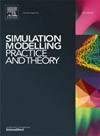高效节能流行病传播模拟的并行化策略
IF 3.5
2区 计算机科学
Q2 COMPUTER SCIENCE, INTERDISCIPLINARY APPLICATIONS
引用次数: 0
摘要
传染病传播的模拟分析对于社会和政府作出适当的反应至关重要。某些基于元胞自动机(CA)的易感-感染-恢复(SIR)模型已被证明是实现这一目的的有效工具。尽管人们对这些模拟模型越来越感兴趣,但很少有研究涉及计算效率。许多模型不是并行化的,因此计算效率很低。此外,计算效率通常只与运行时相关,对能源消耗和节能软件实现的关注有限。本文介绍了在多处理器和图形处理单元(gpu)上成功实现的Covid-19元胞自动机SIR模型的各种并行实现,显著提高了现有代码的性能,同时大幅降低了能耗。这些并行实现的性能分析表明,模拟时间可以从几个小时缩短到不到一秒,能耗降低了三个数量级以上。此外,结果表明,在多个并行多处理器备选方案可用的情况下,CA模拟中最短的执行时间和最低的能耗之间并不总是直接相关的。这项工作旨在支持对实现或利用并行、节能SIR模型模拟未来流行病爆发、绿色计算倡议和有效的元胞自动机模拟感兴趣的从业人员。本文章由计算机程序翻译,如有差异,请以英文原文为准。
Parallelization strategies for high-performance and energy-efficient epidemic spread simulations
Simulation analysis of epidemic disease spread is crucial for a proper social and governmental response. Certain susceptible–infected–recovered (SIR) models based on cellular automata (CA) have proven to be effective tools for this purpose. Despite the growing interest in these simulation models, few studies have addressed computational efficiency. Many models are not parallelized and, as a result, are computationally inefficient. Moreover, computational efficiency is often solely associated with runtime, with limited attention given to energy consumption and energy-efficient software implementations.
This paper presents various parallel implementations of a successful Covid-19 cellular automaton SIR model on multiprocessors and Graphics Processing Units (GPUs), significantly improving the performance of existing codes while substantially reducing energy consumption. The performance analysis of these parallel implementations demonstrates that simulations can be reduced from hours to under a second, with energy consumption reduced by more than three orders of magnitude. Additionally, the results reveal that in cases where multiple parallel multiprocessor alternatives are available, there is not always a direct correlation between the shortest execution time and the lowest energy consumption in CA simulations.
This work aims to support practitioners interested in implementing or utilizing parallel, energy-efficient SIR model simulations for future epidemic outbreaks, green computing initiatives, and efficient cellular automata simulations in general.
求助全文
通过发布文献求助,成功后即可免费获取论文全文。
去求助
来源期刊

Simulation Modelling Practice and Theory
工程技术-计算机:跨学科应用
CiteScore
9.80
自引率
4.80%
发文量
142
审稿时长
21 days
期刊介绍:
The journal Simulation Modelling Practice and Theory provides a forum for original, high-quality papers dealing with any aspect of systems simulation and modelling.
The journal aims at being a reference and a powerful tool to all those professionally active and/or interested in the methods and applications of simulation. Submitted papers will be peer reviewed and must significantly contribute to modelling and simulation in general or use modelling and simulation in application areas.
Paper submission is solicited on:
• theoretical aspects of modelling and simulation including formal modelling, model-checking, random number generators, sensitivity analysis, variance reduction techniques, experimental design, meta-modelling, methods and algorithms for validation and verification, selection and comparison procedures etc.;
• methodology and application of modelling and simulation in any area, including computer systems, networks, real-time and embedded systems, mobile and intelligent agents, manufacturing and transportation systems, management, engineering, biomedical engineering, economics, ecology and environment, education, transaction handling, etc.;
• simulation languages and environments including those, specific to distributed computing, grid computing, high performance computers or computer networks, etc.;
• distributed and real-time simulation, simulation interoperability;
• tools for high performance computing simulation, including dedicated architectures and parallel computing.
 求助内容:
求助内容: 应助结果提醒方式:
应助结果提醒方式:


